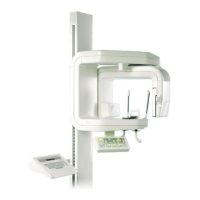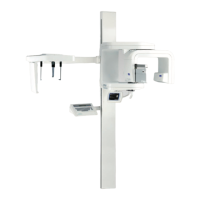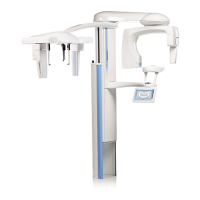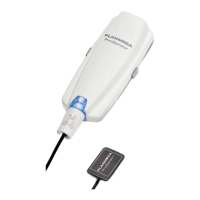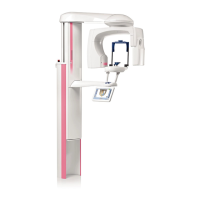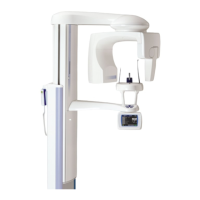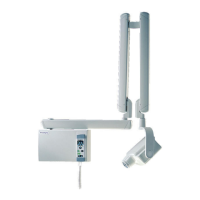Do you have a question about the Planmeca Proline EC pan and is the answer not in the manual?
Covers critical warnings and safety rules for servicing the unit to avoid injury or damage.
Details technical specifications including X-ray tube, generator, voltage, current, and filtration.
Provides guidance and manufacturer's declarations on electromagnetic emissions and immunity.
Explains the keyboard layout, keys, and display indications for normal and service modes.
Describes normal keyboard functions and special user settings accessible in normal mode.
Details functions, keys, displays, and settings available in service mode for technicians.
Lists and explains help messages that appear on the display for various conditions.
Provides a comprehensive list of error codes and their corresponding messages for fault finding.
Detailed explanations for various error codes, including user-related and time-out errors.
Lists necessary tools for performing calibration and adjustment procedures.
Instructions for checking and adjusting the panoramic X-ray beam position.
Procedures for checking and adjusting the patient positioning mechanism.
Details mechanical adjustments for the rotational part, including guiding profiles and limits.
Step-by-step guide for calibrating the Automatic Exposure Control system.
Covers adjustments for the cephalostat, including head support and beam alignment.
Lists specialized tools required for adjusting the Dimax3 digital system.
Procedures for adjusting the panoramic beam with the Dimax3 sensor head.
Detailed steps for calibrating the panoramic sensor head using software tools.
Checking and adjusting the patient positioning mechanism for the Dimax3 system.
Instructions for adjusting the cephalostat components with the Dimax3 system.
Guide on how to shift the image area forwards to avoid cutting the patient's nose.
Covers cleaning procedures for various parts of the X-ray unit.
Details electrical checks, X-ray tube feedback system, and mechanical checks.
Lists error messages and points to sections for detailed explanations and fault finding.
Explains consequences of a flat battery and how to correct substituted information.
Troubleshooting guide for issues related to rotation, cassette movement, and focal trough.
Covers common radiographic issues like no radiograph, underexposure, and image artifacts.
Instructions for removing and replacing various covers of the X-ray unit.
Details on how to replace motors for Z-carriage, rotating arm, and cassette mechanism.
Information on replacing circuit boards, including memory data considerations.
Describes the mechanical structure, components, and overall operation of the unit.
Explains the function and location of electrical components like tubehead and circuit boards.
Details the six motors, their types, operation, and driving power sources.
Describes the three positioning lasers (layer, sagittal, Frankfurt) and their functions.
Covers critical warnings and safety rules for servicing the unit to avoid injury or damage.
Details technical specifications including X-ray tube, generator, voltage, current, and filtration.
Provides guidance and manufacturer's declarations on electromagnetic emissions and immunity.
Explains the keyboard layout, keys, and display indications for normal and service modes.
Describes normal keyboard functions and special user settings accessible in normal mode.
Details functions, keys, displays, and settings available in service mode for technicians.
Lists and explains help messages that appear on the display for various conditions.
Provides a comprehensive list of error codes and their corresponding messages for fault finding.
Detailed explanations for various error codes, including user-related and time-out errors.
Lists necessary tools for performing calibration and adjustment procedures.
Instructions for checking and adjusting the panoramic X-ray beam position.
Procedures for checking and adjusting the patient positioning mechanism.
Details mechanical adjustments for the rotational part, including guiding profiles and limits.
Step-by-step guide for calibrating the Automatic Exposure Control system.
Covers adjustments for the cephalostat, including head support and beam alignment.
Lists specialized tools required for adjusting the Dimax3 digital system.
Procedures for adjusting the panoramic beam with the Dimax3 sensor head.
Detailed steps for calibrating the panoramic sensor head using software tools.
Checking and adjusting the patient positioning mechanism for the Dimax3 system.
Instructions for adjusting the cephalostat components with the Dimax3 system.
Guide on how to shift the image area forwards to avoid cutting the patient's nose.
Covers cleaning procedures for various parts of the X-ray unit.
Details electrical checks, X-ray tube feedback system, and mechanical checks.
Lists error messages and points to sections for detailed explanations and fault finding.
Explains consequences of a flat battery and how to correct substituted information.
Troubleshooting guide for issues related to rotation, cassette movement, and focal trough.
Covers common radiographic issues like no radiograph, underexposure, and image artifacts.
Instructions for removing and replacing various covers of the X-ray unit.
Details on how to replace motors for Z-carriage, rotating arm, and cassette mechanism.
Information on replacing circuit boards, including memory data considerations.
Describes the mechanical structure, components, and overall operation of the unit.
Explains the function and location of electrical components like tubehead and circuit boards.
Details the six motors, their types, operation, and driving power sources.
Describes the three positioning lasers (layer, sagittal, Frankfurt) and their functions.
| Tube Voltage | 60-90 kV |
|---|---|
| Tube Current | 2-16 mA |
| Software | Planmeca Romexis |
| Imaging Mode | Digital |
| Type | Panoramic |
| Imaging Modalities | Panoramic |
| Focal Spot Size | 0.5 mm |
| Sensor Type | CCD |
| Image Sensor | CCD sensor |
| Power Requirements | 230 VAC, 50/60 Hz |
